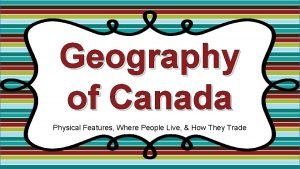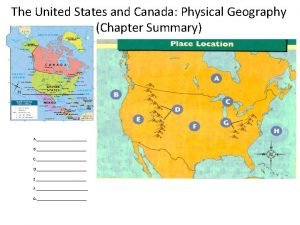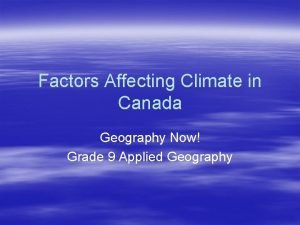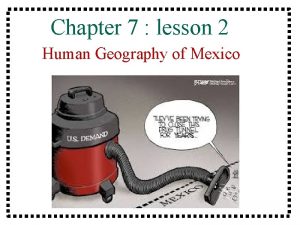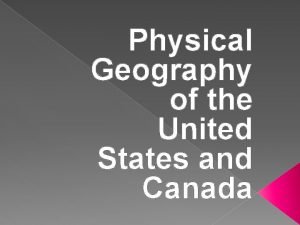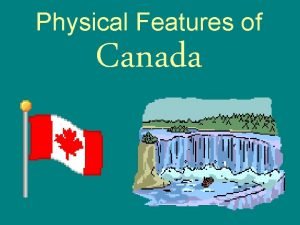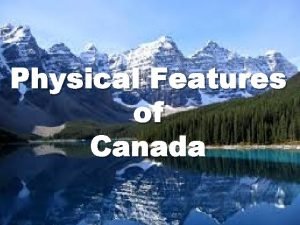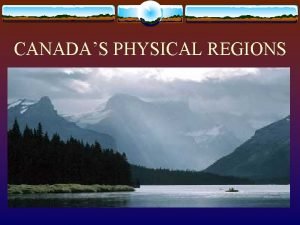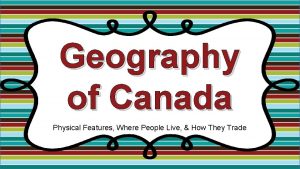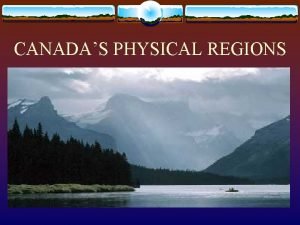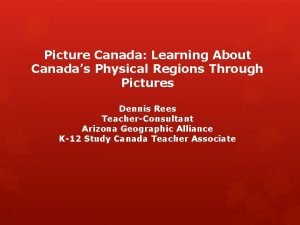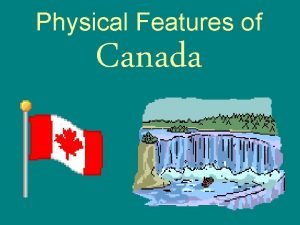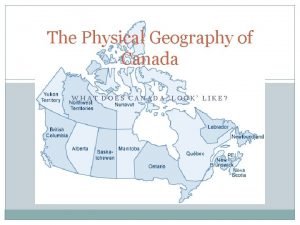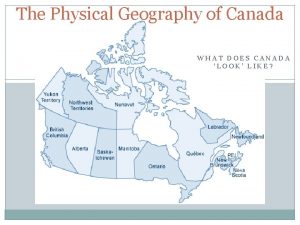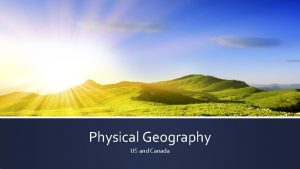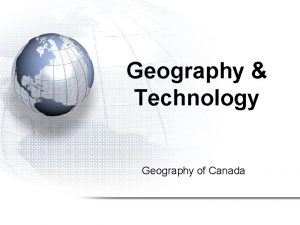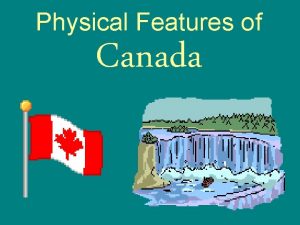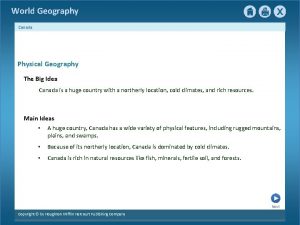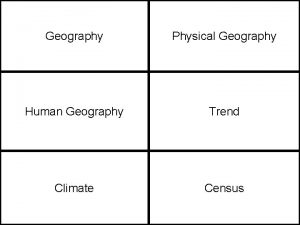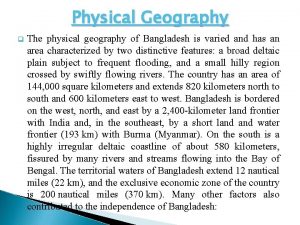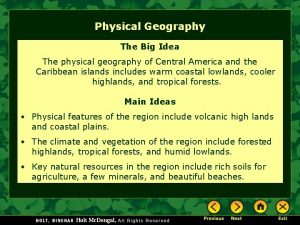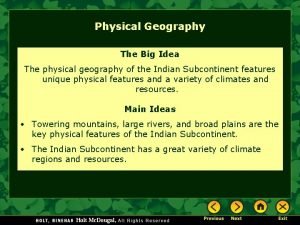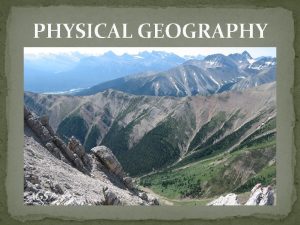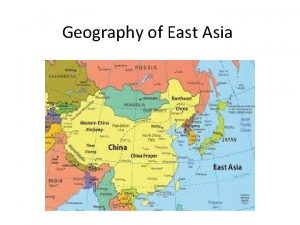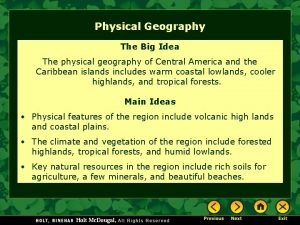Physical Geography of The U S Canada EQ




















- Slides: 20

Physical Geography of The U. S. & Canada EQ: Discuss main geographic landforms of the U. S. & Canada and examine varied landforms in relation to their lifestyles.

Places & Terms for Discussion Appalachian Mountains Great Plains Canadian Shield Rocky Mountains Great Lakes Mackenzie River Prevailing Westerlies Everglades Lock St. Lawrence Seaway

Physical Map Image of North America

Political U. S. Map

Political Look at Canada

Landforms & Resources Total Land Area 1 st place- Russia 2 nd place- Canada 3 rd place- USA The US and Canada fill 1/8 of the land surface of the Earth.

Landforms & Resources Both countries are rich in natural resources. Fertile soil Ample water supplies Vast forests Variety of minerals All of these have attracted immigrants from around the world and allowed both countries to develop into global powers.

Natural Resources Examine the map of the U. S. and Canada’s resources on pg. 120 and answer the following questions: 1) What resources seem to appear the most in the U. S. ? 2) Which energy resource is more widespread in Canada than in the U. S. ? Why is this? 3) What are some advantages Canada and the U. S. may have as a result of their abundant resources?


Landforms & Resources Many Varied Landforms Eastern Lowlands: Flat coastal plain runs along the Atlantic Ocean & Gulf of Mexico. (Atlantic Coastal Plain)

Landforms & Resources Many Varied Landforms Appalachian Highlands: Gently sloping Appalachian Mts. Have been eroded over time Considered to be over 400 million years

Landforms & Resources Many Varied Landforms Interior Lowlands: Flattened by glaciers thousands of years ago. Terrain varies between lowlands, hills, lots of lakes & rivers. 3 sub-regions: Interior Plains/ Great Plains/ Canadian Shield

Landforms & Resources Western Mountains, Plateaus, & Basins: Rocky Mountains range 3, 000 miles from Alaska south to New Mexico. Thought to be around 80 million years old.

Landforms & Resources Continental Divide: marks the separation between rivers flowing eastward & westward Mt. Mc. Kinley: North America’s highest peak at 20, 300 ft is in Alaska.

Landforms & Resources Oceans & Waterways: Great Lakes: Huron Ontario Michigan Erie Superior Forms one of the worlds most important shipping routes along with the St. Lawrence River.

Landforms & Resources Oceans & Waterways: Mississippi River: River begins out of Lake Itasca in northern Minnesota It flows 2, 350 miles to the Gulf of Mexico It drains 31 states and its watershed covers 40% of the continental US. Once known as the longest river in the US, it has since lost that title to the Missouri River, which has had its length corrected to 2, 540 miles. Source: https: //www. nps. gov/miss/riverfacts. htm Mackenzie River: Canada’s longest river

Features of Canadian and U. S. Landforms Rocky Mountains Great Plains Canadian Shield Appalachian Mountains Western mountain chain Mostly treeless area Rocky and Flat Eastern mountain chain Extends 3, 000 miles from New Mexico to Alaska 4, 000 feet above sea-level Lies in northeast Canada 1, 600 miles from Alabama to Newfoundland Its highest point is called the “Continental Divide” Runs from southern Texas Covers about 1. 8 million up through southern square miles Canada Includes the Green, Catskill, and Smoky Mountains 80 million years old Its fertile soil allows crops Encircles the Hudson Bay to grow in abundance 400 million years old

Climate & Vegetation Almost every climate type can be found in the U. S. because it extends over such a large area. Canada’s cold climate is related to its location in the far northern latitudes. Some places there is permafrost, or permanently frozen ground. Prevailing Westerlies, winds that blow from west to east in the middle latitudes, keep the summers warm and the winters mild along the Pacific Coast and coastal mountains.

Climate & Vegetation The Everglades, found in southern Florida, has a tropical wet and dry climate is a huge swampland that covers some 4, 000 square miles.

Human – Environment Interaction Settlement: First inhabitants were nomads who moved from place to place. Archaeologists believe they migrated from Asia over the Beringia land bridge. Hunting & Gathering was their Primary method of food production before they began to cultivate crops.
 Canada physical regions
Canada physical regions Does canada have mountains
Does canada have mountains Geography now canada
Geography now canada What influenced mexico’s political and social structures?
What influenced mexico’s political and social structures? United states and canada physical map
United states and canada physical map Do the great lakes connected to the ocean
Do the great lakes connected to the ocean Important physical features of canada
Important physical features of canada Physical regions of canada
Physical regions of canada Physical features of canada
Physical features of canada Physical regions of canada
Physical regions of canada Physical regions in canada
Physical regions in canada Important physical features of canada
Important physical features of canada Ap human geography frq examples
Ap human geography frq examples 5 themes of geography ap human geography
5 themes of geography ap human geography Proruption ap human geography
Proruption ap human geography Hình ảnh bộ gõ cơ thể búng tay
Hình ảnh bộ gõ cơ thể búng tay Bổ thể
Bổ thể Tỉ lệ cơ thể trẻ em
Tỉ lệ cơ thể trẻ em Gấu đi như thế nào
Gấu đi như thế nào Tư thế worm breton
Tư thế worm breton
